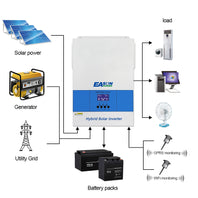In the realm of solar energy, the maximum power point tracking controller (MPPT) plays a pivotal role in enhancing the efficiency of photovoltaic systems. By continuously adjusting the electrical operating point of the modules, MPPT ensures that solar panels operate at their optimal power output. This article delves into the intricacies of MPPT technology and its significance in solar energy harvesting.

What is a Maximum Power Point Tracking Controller?
The maximum power point tracking controller is an electronic device that maximizes the power output from solar panels. It achieves this by monitoring the voltage and current output of the solar array and adjusting the load to ensure that the panels operate at their maximum power point (MPP). But how does it do this? The MPPT uses algorithms to determine the optimal voltage and current conditions, allowing for efficient energy conversion.
How Does MPPT Work?
To understand the functionality of a maximum power point tracking controller, it is essential to grasp the concept of the power-voltage curve. This curve illustrates the relationship between the voltage and current output of a solar panel. The MPP is the point on this curve where the product of voltage and current is maximized. The MPPT continuously adjusts the electrical load to keep the solar panels operating at this point, even as environmental conditions change.
- Real-time Monitoring: MPPT controllers constantly monitor solar panel output.
- Dynamic Adjustment: They adjust the load to maintain optimal performance.
- Algorithm Utilization: Various algorithms, such as Perturb and Observe (P&O) or Incremental Conductance, are employed for efficiency.
Benefits of Using MPPT Controllers
Implementing a maximum power point tracking controller in solar energy systems offers numerous advantages:
- Increased Efficiency: MPPT can improve energy harvest by up to 30% compared to systems without it.
- Adaptability: It adjusts to varying weather conditions, ensuring consistent performance.
- Cost-Effectiveness: Higher energy output translates to better return on investment for solar installations.
Choosing the Right MPPT Controller
When selecting a maximum power point tracking controller, consider the following factors:
- System Compatibility: Ensure the controller matches your solar panel specifications.
- Power Rating: Choose a controller with a power rating that meets or exceeds your system's requirements.
- Features: Look for additional features such as remote monitoring and data logging capabilities.
For those interested in exploring high-quality solar charge controllers, visit to find a range of options that incorporate advanced MPPT technology.
Conclusion
In conclusion, the maximum power point tracking controller is an essential component for optimizing solar energy systems. By ensuring that solar panels operate at their maximum efficiency, MPPT technology not only enhances energy output but also contributes to the overall sustainability of solar energy solutions. As the demand for renewable energy continues to grow, understanding and implementing MPPT technology will be crucial for maximizing the benefits of solar power.





